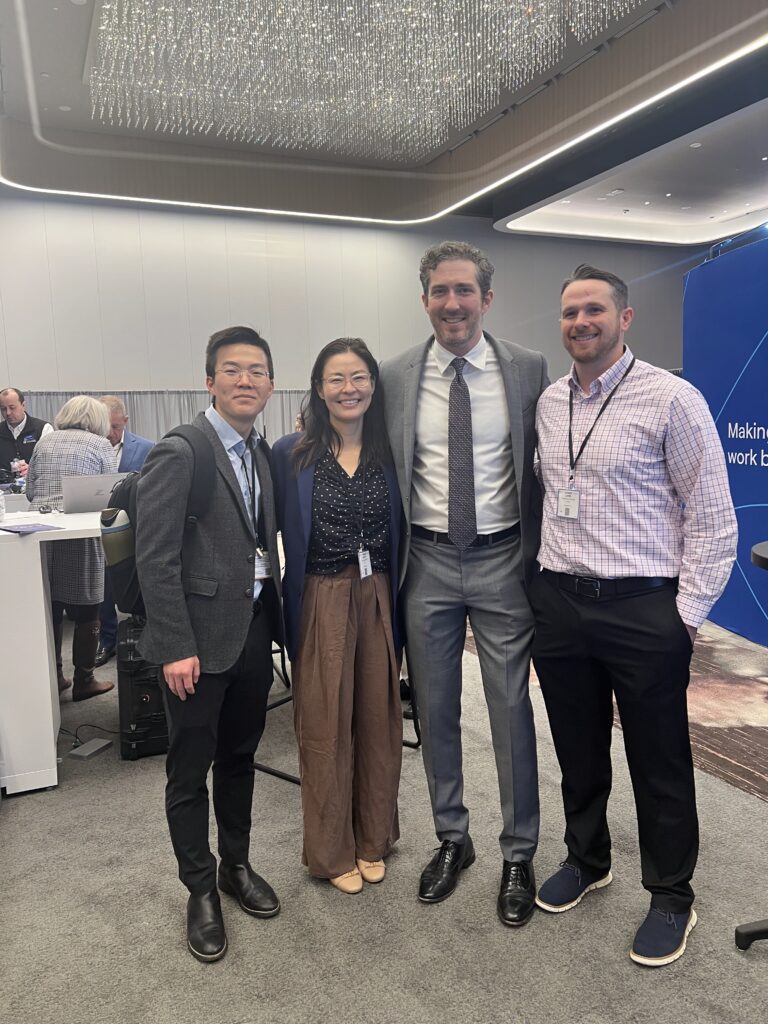Brian Lee, MD, MBA, Chris Muse-Fisher, MD, MBA, and Kathy Cazares, MD, MBA
This January, the California Society of Anesthesiologists (CSA) sponsored three residents to attend ASA Advance: The Anesthesiology Business Event in Atlanta, Georgia. This conference brings together anesthesiologists to discuss the complexities of our healthcare system—diving into issues like practice management, economics, operational excellence, and the challenges of negotiating with payers and administrators.
Our key takeaways from the conference:
Physicians May be Viewed as Commodities by Healthcare Administrators
Market instability in anesthesia was a key theme. One striking example came from Providence hospitals in Portland, Oregon, where the replacement of a contracted anesthesia group led to a 50% drop in elective surgeries at two hospitals. Similarly, anesthesiologists at Cedars-Sinai faced significant challenges after becoming direct employees of the healthcare system, ultimately leading to unionization. These cases underscored the critical need for effective communication with hospital administrators—especially when advocating for fair compensation for undervalued services.
Physicians Must Speak Up to Educate and Advocate
A major highlight of the conference was the keynote address by Dr. Glaucomflecken, the ophthalmologist-comedian known for his satirical takes on medicine. He shared his own experiences as both a physician and patient, using humor to expose the deep flaws in our healthcare system. One particularly powerful example was his battle against $20,000 in insurance denials, echoing the public’s frustration with insurers like UnitedHealthcare. He also discussed the recent Anthem Blue Cross Blue Shield policy (https://youtube.com/shorts/vWA2aQYXDbo?si=6Cq18or0Sbok2rgl) that attempted to limit payment for anesthesia services—an overreach that faced swift backlash and was ultimately withdrawn. Dr. Glaucomflecken praised the ASA’s advocacy efforts and urged physicians to support the ASA advocates and also use their own voices—whether in public forums or on social media—to educate and advocate for change, even if we don’t have all the solutions yet.
There Are Many Career Paths in Anesthesia
As residents, we gained valuable insight into the evolving job market. The conference shed light on various practice models, including private practice, academic medicine, and health system employment, with options for MD-only, supervision, and medical direction roles. One notable trend: new graduates increasingly prioritize predictable hours and work-life balance over fellowship training—a shift that is reshaping hiring patterns in the field. Besides cardiac and pediatric anesthesia, a growing number of graduating anesthesiologists also find that they are able to secure jobs without a fellowship both within and outside of academic institutions providing flexibility for new graduates. In addition, the conference shared many avenues for how anesthesiologists can be leaders in perioperative care in academic and in private practice institutions.
Physician Well-Being and Burn Out
The conference highlighted the importance of our own holistic well-being as anesthesiologists and the importance of preventing burn out. Surveys have shown that approximately 50% of anesthesiologists report feeling burnt out. The factor that contributed most to burn-out was too much bureaucratic taste (e.g., charting, paperwork) (60% reported) followed by lack of respect from administrators/employers, colleagues, or staff (39% reported) then followed by working too many hours at work (34% reported). These factors highlight how administrative organization and culture of a practice have immense influence on physician well-being in and outside of work. As future leaders in perioperative care, it is important that we coordinate our practices to optimize our workplace with a focus on physician well-being.
The Benefits of Coaching in Medical Education
Transitioning from learner to educator requires adaptability. A coaching approach—focused on individualized support and continuous feedback—enhances engagement and reduces burnout. Institutions fostering mentorship can improve retention, morale, and workplace satisfaction.
Transitioning from learner to educator can be daunting, particularly in an environment where learning styles and expectations continue to evolve. Several discussions at the conference explored strategies to navigate this shift effectively, emphasizing the importance of moving from a traditional instructor role to that of a coach.
A coaching-based approach offers greater flexibility, allowing educators to adapt to diverse learning styles while fostering a more personalized and holistic educational experience. Unlike a managerial style, which may focus on rigid structures and top-down instruction, coaching prioritizes individualized support, skill development, and continuous feedback. This method not only enhances motivation and engagement but also creates a more inclusive and supportive learning environment.
Beyond its impact on education, the coaching model plays a crucial role in physician well-being. A lack of support has been identified as a significant contributor to burnout, and by cultivating a culture of mentorship and guidance, institutions can improve staff retention, promote wellness, and strengthen workplace morale. Ultimately, shifting from a managerial to a coaching mindset benefits both learners and educators, creating a more dynamic, fulfilling, and sustainable teaching environment.
Attending ASA Advance reinforced the importance of staying informed, engaged, and proactive in shaping the future of our specialty. As anesthesiologists, we are not just providers of a service—we are key stakeholders in the healthcare system.

